As a freelancer, one of your main concerns is finding a steady stream of clients. While there are many places to come in contact with potential customers, chances are you have come across a Freelance Marketplace at some point.
Freelance platforms are websites that act as a middleman between clients and freelancers.
They have been around for a long time, and more are popping up in response to more people deciding to work from home is a good alternative to being a regular employee.
But, which ones are worth your time?
What are the Best Freelance Websites for Independent Contractors?
While the general concept of a marketplace is being a place where clients and freelancers can find each other, they don’t all work the same.
Is up to you to evaluate which one fits best according to your needs and work experience.
In this list, I will focus on:
- Working methodology.
- Fees.
- Project quantity and quality: how many clients are it, and what type of projects are they posting.
Best Overall: Upwork
Best for: Freelancers who want to access clients all over the world, regardless of their experience.
Upwork is one of the bigger (if not the biggest) freelance marketplaces. As a freelancer, you get access to a wide range of job opportunities from clients all over the world.
However, this is a double-edged sword. Thousands of new job posts are published each day, but there is also fierce competition to have clients award you those jobs.
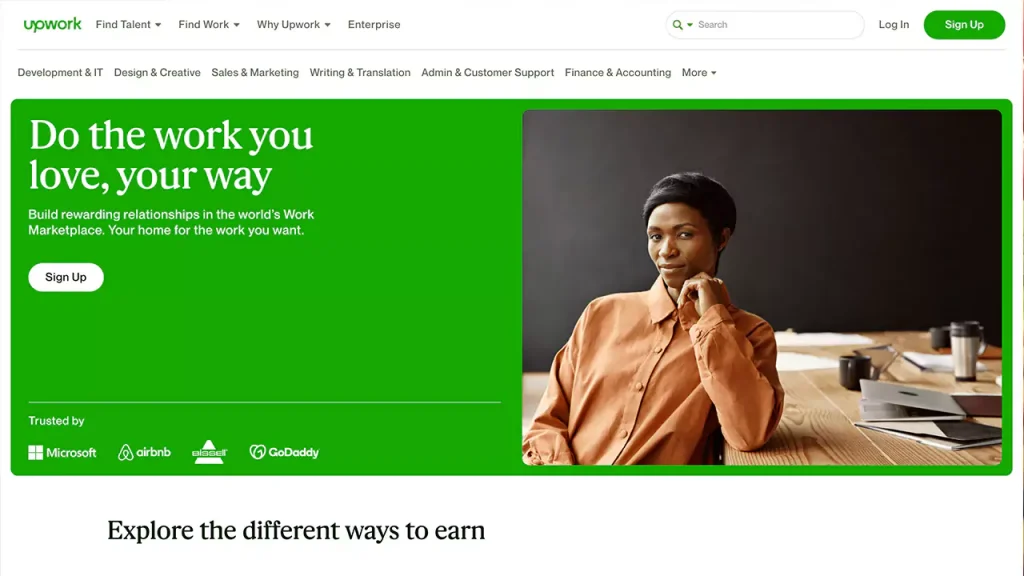
How does Upwork work?
You can get clients on Upwork in several ways:
- By bidding on job posts using Connects (the platform “currency”). Once you negotiate the project scope and pricing, the client awards you the job (fixed-priced or hourly) and you get to work.
- Another option is to create “projects”, similar to Fiverr’s gigs. Clients can search for what they need in Upwork’s marketplace, and place an order for each project.
- You can apply to their recruiting program where they match you with potential clients. The recruiters receive the client’s requirements and search for the best fit.
- By having clients contact you directly through your profile.
You have different freelancing levels depending on your performance, reviews, and how much money you earn in a year.
They seem to cover all the basics when it comes to coming into contact with potential clients.
Fees:
Upwork charges a sliding fee for each client’s lifetime. Basically, the more you earn with a client the less you pay:
- 20% for the first $500.
- 10% for earning between $501 and $10000.
- 5% for earning over $10001.
Every account receives free connects each month but you can buy more if you spend them all.
You can also become a Freelancer Plus, Upwork’s membership program for $14.99, and receive some more perks.
Project quantity and quality:
There are a lot of potential clients and new job posts are published constantly. However, competition is also fierce and you need to learn how to sell your services in order to stand out from other freelancers.
As such, the job quality varies. There is a wide range in prices and types of clients. You can land well-paying jobs if you spend some time looking for them among the low-paying ones.
Sadly, Upwork has a nasty problem with scam job posts. You need to learn and pay attention to red flags to avoid falling for a fake client.
The good about Upwork:
- Wide variety of jobs and prices.
- Different ways of finding clients on the platform.
- They provide a lot of tools that make your job easier.
The bad about Upwork:
- Lots of competitors.
- Scammers are a problem.
- You need to have experience and sales skills to get the best jobs.
Best for small jobs: Fiverr
Best for: Freelancers who offer small, packaged services.
Fiverr is one of the best well-known freelance platforms in the market. They got their fame by offering “gigs” for the low price of $5. However, things have changed since then and now you can find high-paying offers as well.
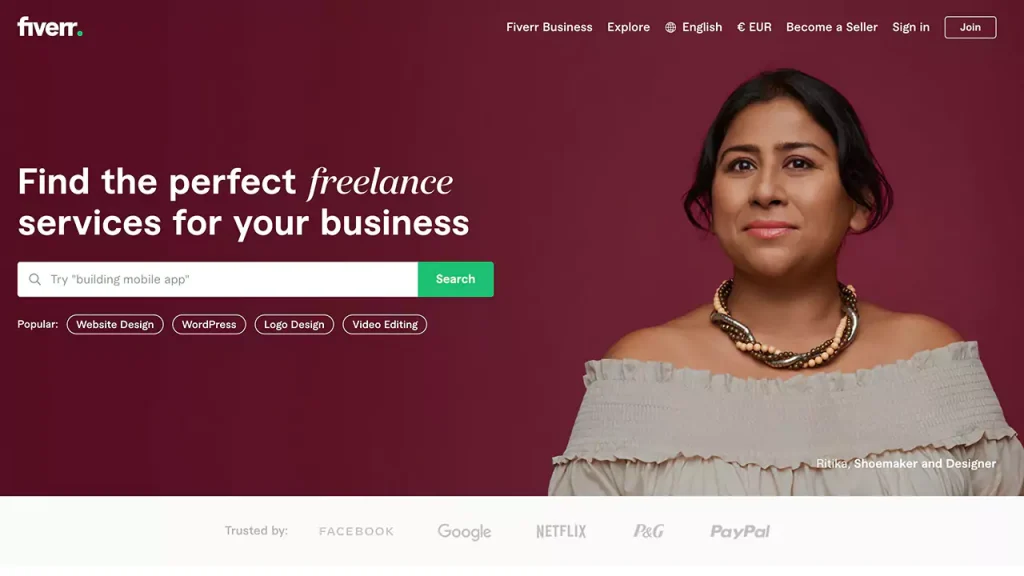
How does Fiverr work?
- Offering your services on Fiverr is simple. Just create a profile and set up gigs according to your skills.
Gigs are service packages with very defined deliverables. Clients can search for freelancers or types of jobs, read exactly what they are offering, and hire a professional with just a couple of clicks.
These packages can have up to 3 different deliverable levels and prices, making it easier to upsell your services to clients.
While Fiverr is well known for traditional freelance professions, you can also find original gigs like becoming your friend for a day.
Clients can also give you a tip for a good job.
Fiverr is one of the few platforms that also offers courses for freelancers and self-employed professionals.
Fees:
- 20% flat rate for gigs and tips.
Project quantity and quality:
There is a wide range of offerings on Fiverr. From $5 (the minimum you can charge) up to $995 per gig.
You structure a gig with 3 different price points and change the deliverables depending on the price.
Many clients are looking to hire freelancers on Fiverr for smaller jobs paying as little as possible. If you want to earn a lot of money on Fiverr, the secret is to offer low-cost services that you can deliver as quickly and easily as possible.
The good about Fiverr:
- A lot of clients search for and hire freelancers on Fiverr.
- A simple upsell system allows you to earn more money for the same service.
- You can offer all kinds of services as long as they comply with Fiverr’s TOS.
The bad about Fiverr:
- Clients go to Fiverr looking to pay as little as possible.
- You need to learn how to structure your gig following SEO best practices and how to promote your services outside the platform.
- There is a lot of competition and it is hard to get those first clients.
Best for Highest paid jobs: Toptal
Best for: Freelancers who are looking to work for bigger companies and startups.
Toptal has positioned itself as the platform where you find only the best freelancers. Their exhaustive onboarding process takes care of selecting professionals with experience and proven results.
Startups and tech companies are among their most common clients.

How does Toptal work?
Working on Toptal is not the same as on other platforms. Is not enough to create an account. You need to apply and pass their screening process which consists of several tests depending on your profession and experience, including language skills.
If you get approved, you can land clients in 2 ways:
- Potential clients can find your profile and hire you
- Or -what actually makes Toptal shine- the client tells the platform what they need and recruiters are tasked to find the right professional for the job.
You set your own hourly rate. There are no fixed-price projects.
Fees:
- 0% if you are a service provider. However, fees are steep if you are a client.
Project quantity and quality:
Toptal is well known for attracting big brands and clients looking to hire top-notch freelancers. This reflects in the prices clients are willing to pay for the right professional.
However, if your profile is not a good match or your skills are not in demand, getting a job through this platform is going to be hard.
The good about Toptal:
- Highest paying freelancer marketplace.
- You get the chance to work for big brands and companies.
- As a freelancer, you pay no fees.
The bad about Toptal:
- It is very hard to get approved to work on Toptal.
- If your skills are not on-demand, is hard to get clients to hire you.
Best for Spanish-speaking freelancers: Workana
Best for: Freelancers who want Spanish-speaking clients.
Workana is the biggest freelance marketplace for Spanish-speaking freelancers and clients.
Even though having a platform dedicated to this specific language makes it stand out from other options, there are many more freelancers than clients making it extremely competitive for self-employed professionals.
Lately, they have been expanding to other languages as well.
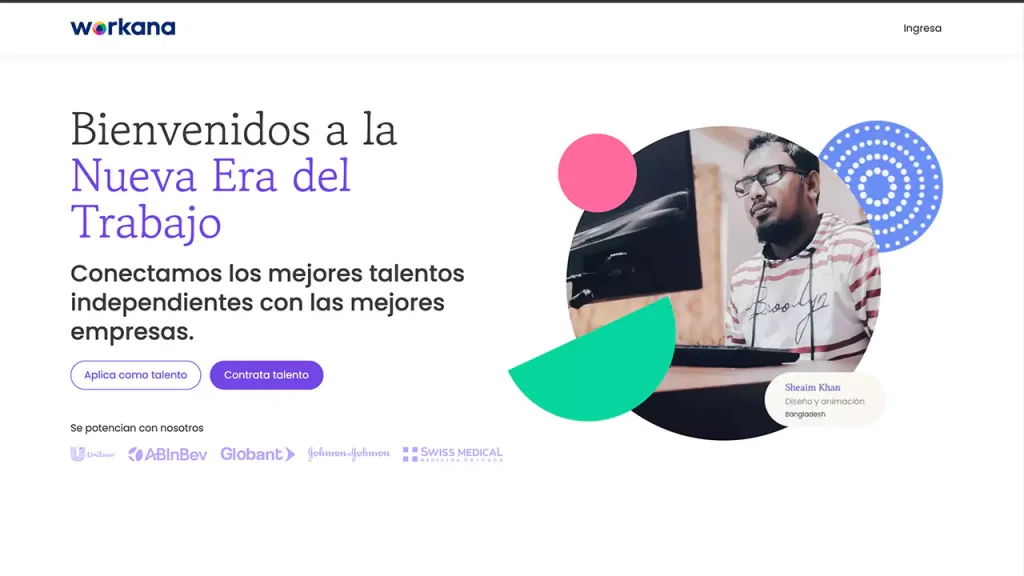
How does Workana work?
- Clients post a project and freelancers apply by sending a proposal. If the client is interested, you get a reply and negotiate the details before getting hired.
Fees:
Similar to Upwork, Workana has a staggered commission depending on your earnings per client.
- 20% from $0 to $300.
- 10% from $301 up to $3000.
- 5% from $3001 and up.
You can also opt to purchase a Membership Plan starting at $4,90 per month.
Project quantity and quality:
Workana has been growing more each year, but even if you can find more job opportunities now than a few years ago, the amount of freelancers applying to projects has also increased.
This makes it very hard for self-employed professionals to stand out, and most of them have to compete by lowering their prices.
The good:
- It’s a Spanish-speaking platform, ideal for freelancers who don’t speak English.
The bad:
- Highly competitive, clients receive tens of proposals per job.
- Projects are usually low-paid.
Freelancer.com
Best for: Freelancers selling services beyond the typical freelance professions.
Freelancer is one of the oldest freelance marketplaces. You can find job posts in over 1800 categories, meaning there is a place for almost every profession.
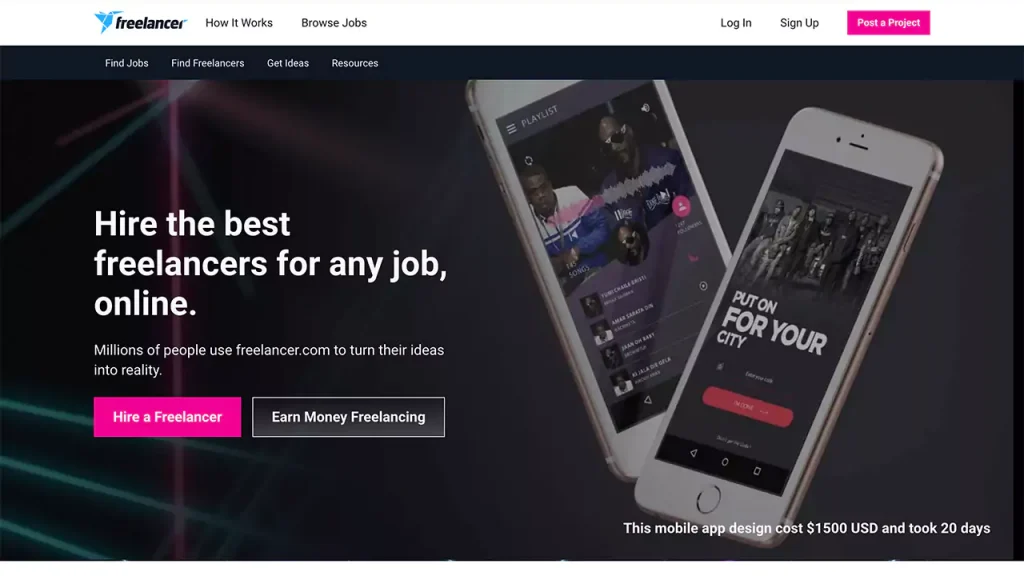
How does Freelancer work?
There are 3 ways you can get clients at Freelancer.
- You can bid on a job post by sending a proposal. If the client likes your cover letter, then you negotiate the price and project scope.
- If you qualify, you can become a service provider by accepting to do certain tasks at a pre-defined price and timeline. You can’t choose the price or negotiate the scope.
- And finally, you can participate in contests by making the work itself. Be aware that you only get paid if the client chooses you as the winner.
Fees:
- You get 6 free bids per month, with the option to purchase more if needed.
- For fixed-priced projects, the fee is 10% or $5, whichever is the highest.
- For hourly projects, the fee is 10%
- If you are awarded a contest, you pay 10% or $5, whichever is greater.
- For services, Freelancer charges 20% of the fixed price.
However, there are more fees when working on this platform.
Project quantity and quality:
This platform is really big and you can find virtually any type of job post.
They have a consistent amount of clients so even if there are a lot of freelancers as well, it is not impossible to compete. However, jobs tend to be low-paid.
The good:
- Big platform and has lots of clients.
- You have different ways to get clients.
The bad:
- There are a lot of fees involved when working on Freelancer.
- Contests.
Guru
Best for: Freelancers who like how Freelancer.com works.
Guru is also a big freelancer website, with a wide range of job post categories, similar to Freelancer.com
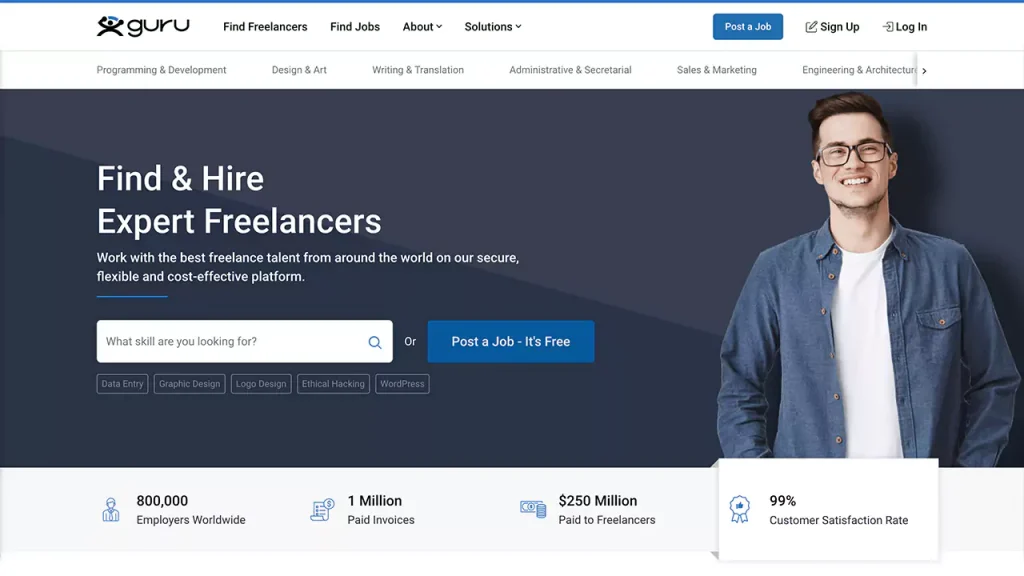
How does Guru work?
Guru’s methodology is pretty straightforward:
- Clients post jobs, you make a bid, and get hired if the client agrees with your proposal.
This platform allows you to ask the client for more details before bidding if you are willing to pay for it.
Fees:
- Creating an account is free, but you can opt for a membership plan from $11.95 to $49.95 per month.
- You get 10 bids per month for free, and you can buy extra bids if needed without committing to a membership plan.
- Projects have a 9% base fee that you can divide with your employer.
Project quantity and quality:
This is a big platform so you have a wide variety of job posts and quite a few freelancers applying.
Jobs on Guru tend to have a slightly higher budget than those on Freelancer, but it will always come down to a basis-by-basis case.
The good about Guru:
- Low fees that you can share with your clients.
- Slightly better-paid jobs than the ones on Freelancer.com
The bad about Guru:
- Only one way to get clients.
- There are a lot of scams on this platform.
99Designs
Best for: Freelancers who like contests.
99Designs is aimed mostly at all kinds of designers: graphic designers, web, illustrators, and more.
This platform is well-known because of its contest system.
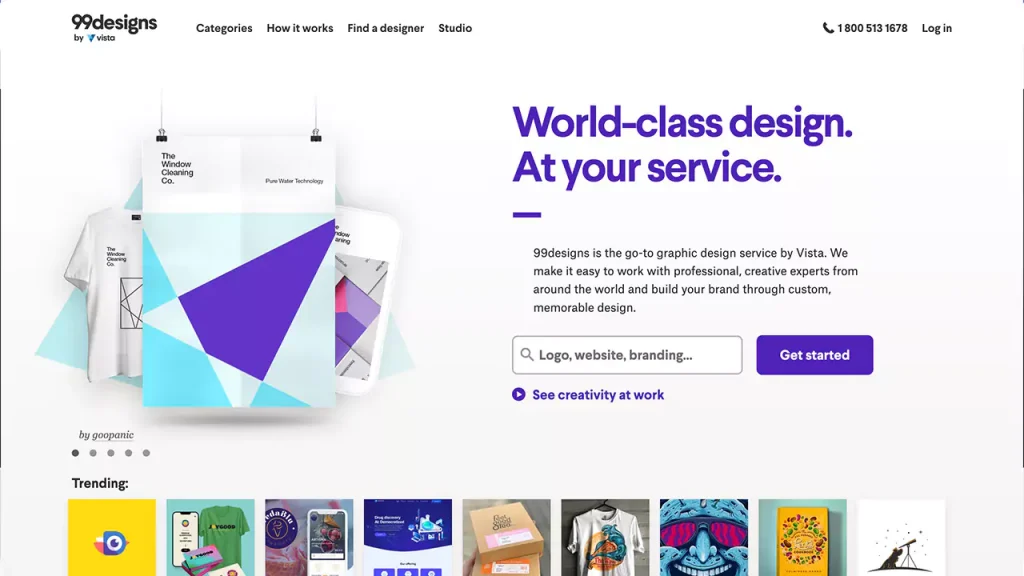
How does 99Designs work?
You can work on this platform in 2 different ways.
- The client can search for your profile and invite you to work on a project directly. This means your portfolio must be top-notch if you want to stand out from other designers.
- The other option is participating in contests. This is Spec Work, meaning you only get paid if the client chooses you as the winner.
There are no job posts.
Fees:
- Fees depend on your skill level. 15% for entry-level designers, 10% for mid-level, and finally, top freelancers pay 5%.
- You have to pay $100 as a Client Introduction Fee for every new client who hires you, to be paid in the first 5 jobs with that same client.
Project quantity and quality:
You have a little bit of everything -design-wise- but it generally attracts low-paying clients because of the contest system.
This platform is “useful” if you have no experience as a designer and are looking to add some work to your portfolio. Keep in mind you are not going to get paid for most of it.
The good about 99Designs:
- Good for designers without experience.
The bad about 99Designs:
- Crazy fees.
- Spec Work.
People Per Hour
Best for: Freelancers who want to work for clients in the UK.
This platform from the UK is not as big as others but you can find a nice range of job posts. It’s aimed at traditional freelance services: copywriting, design, development, etc.
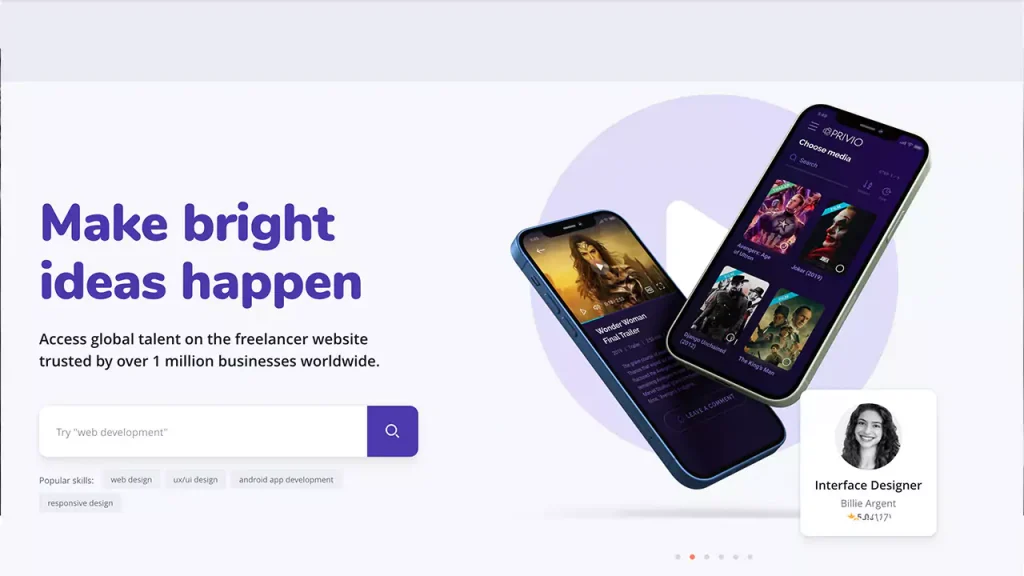
How does People Per Hour work?
You can get clients on People Per Hour by:
- Bidding on a job post
- Having the clients invite you directly through your profile
- Or you can publish an offer for a specific service and price.
Having an amazing profile is important if you want to stand out from the crowd.
Fees:
- You can create an account for free, but have to get approved before working on the platform.
- Fees per project are subject to your lifetime earnings, starting at 20% down to 3,5% + VAT once you earn more than £5000.
Project quantity and quality:
People Per Hour attracts clients mostly from the UK, so they don’t have as many projects as the bigger platforms. But, there are not as many freelancers either.
The good about PeoplePerHour:
- Great if you are looking for clients in the UK.
- Not as much competition as in other freelance marketplaces.
The bad about PeoplePerHour:
- Fees can be high when you are starting.
- Clients tend to prefer hiring local freelancers.
Outsourcely
Best for: Freelancers who want to work as remote employees.
Outsourcely has a focus on remote workers instead of freelancers. Companies post job posts with part or full-time requirements, and you get to apply as a remote employee.
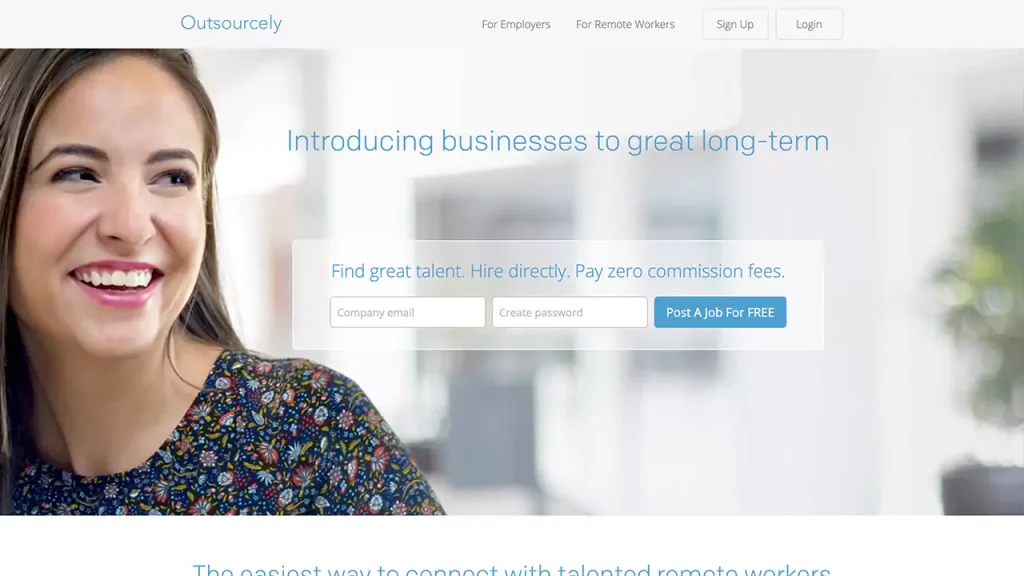
How does Outsourcely work?
As a remote worker, you create a profile with your skills and your desired salary in US dollars. Employers can either search for you in Outsourcely’s database, or you can apply for job posts and go through a traditional hiring process.
The platform is a middleman between companies and employees.
Fees:
- 0% if you are a remote worker.
- You can opt for a Featured Profile membership for $10 per month.
Project quantity and quality:
There is a variety of jobs, but they tend to be pretty simple and don’t pay as much. It seems that clients here are just looking for inexpensive employees.
ServiceScape & Writer Access
Best for: Freelance writers and translators.
ServiceScape & Writer Access are platforms with a focus on writers and translators.
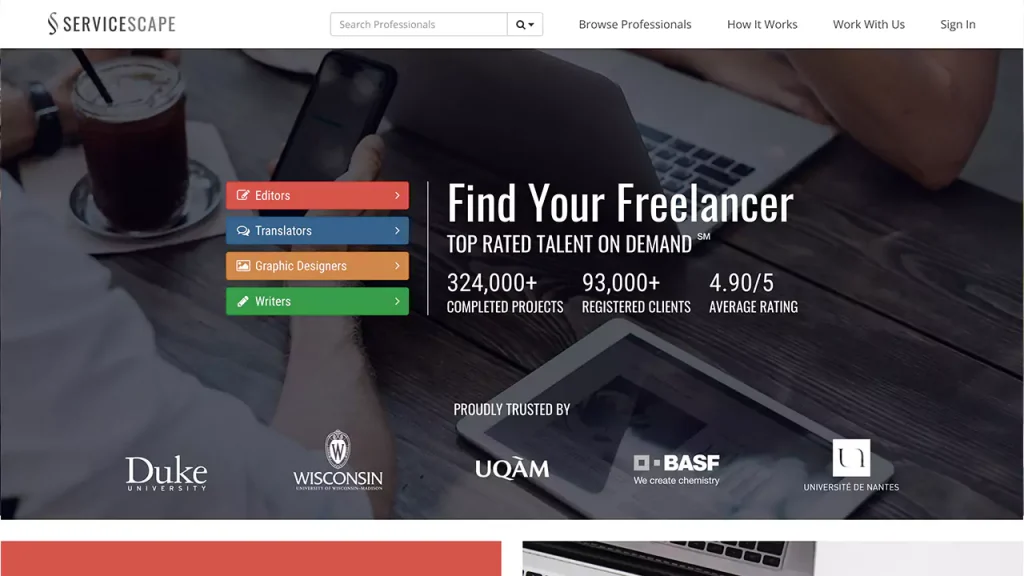
How do ServiceScape & Writer Access work?
- Clients hire freelancers by searching among all the profiles on these platforms.
You create an account, upload your portfolio, and a rate “suggestion”. Your work needs to be top-notch to stand out from other writers.
Writer Access has the option to match clients and freelancers using their AI system.
Fees:
- Service scape has a 50% fee per job.
- Writer Access’ fee is 30%.
Project quantity and quality:
Since there are no job posts, it is hard to see how many clients are looking to hire freelancers on these marketplaces.
However, it is important to note that you can only open an account on ServiceScape or Writer Access depending on the country you are residing in.
We Work Remotely
Best for: Remote employees looking to work worldwide.
We Work Remotely claims to be the biggest remote working platform in the space. It functions as a job board for freelancers.
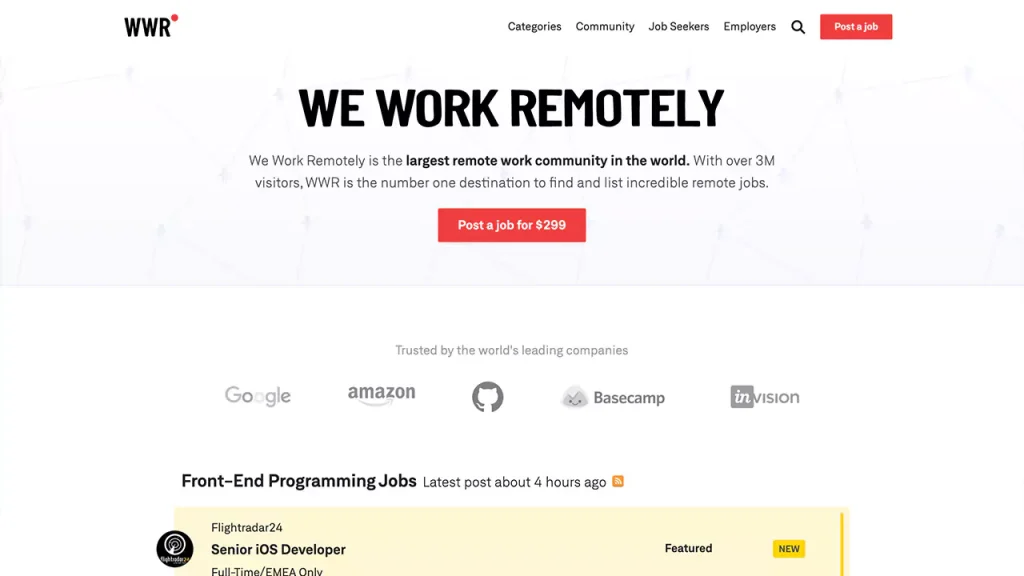
How does We Work Remotely work?
- Super simple. You create a profile, explore the job board, and apply. Then you go through a topical hiring process.
Clients can’t see freelancer profiles unless they apply for a position.
Fees:
- 0% for remote workers.
Project quantity and quality:
The job listings are varied and have a wide price range. Some of them are fully remote, and others require you to go to the office once in a while.
However, there are not many job offerings making it very competitive for applicants.
More Freelance Websites
- AngelList Talent
- Aquent
- Bark
- Behance
- Brybe
- Catalant
- Codeable
- College Recruiter
- CrewScale
- CrowdSource
- crowdSPRING
- DesignContest
- DesignCrowd
- Designhill
- Dribbble
- Envato Studio
- Fancy Hands
- Flexjobs
- Flexjobs
- Hireable
- Jooble
- Kimp
- Konker
- MarketerHire
- Mayple
- Nexxt
- Panda Copy
- ProductionHUB
- SimplyHired
- Solidgigs
- SolidGigs
- TaskRabbit
- Testbirds
- Thumbtack
- Truelancer
- Upstack
- Webflow Experts
- Working Not Working
- YunoJuno
Best Freelance Websites – FAQs
What is a freelance platform or marketplace?
Freelance websites are places that connect clients and freelancers. They act as middle-man between interested parties, offering different services like escrows, mediation, and more by charging a fee to both clients and self-employed professionals.
Not all freelance marketplaces work exactly the same. Some are more involved in the process while others function only as job boards.
Clients and companies can hire independent contractors for specific projects, or as remote workers.
How to choose the best freelance website for you?
Every freelance platform is different. When looking for the right website to offer your services as a freelancer, you need to think about:
– Fees. How much does it cost to use the platform?
– Protection. What protection does it offer for both freelancers and clients?
– Job offerings. Are there many jobs? Are those interesting, with decent budgets?
– Competitors. How many proposals do clients receive for a particular job? Is it too difficult to stand out from other independent contractors?
Depending on your needs, you can choose the most suitable website as a freelancer.
How Much Do Job Listing Websites for freelancers cost?
You can open an account for free on most websites. Some are free to use, while others will keep a percentage of your earnings or offer memberships in exchange for more perks.
Be sure of every fee before committing to a specific platform to avoid unwanted surprises.
Is Using a Freelance Job Site Worth It?
If you are a self-employed professional looking for clients, Freelance Websites are not the only option to find new projects.
However, they make it much easier to get in contact with potential clients who are ready to hire someone to solve their needs and work on projects you may have not found on your own.
Using these marketplaces is worth it while you work on your brand and learn how to reach new clients.
Should you Sign Up for multiple Freelancing sites?
The most difficult obstacle when working on Freelance websites is crafting a solid reputation with a strong profile and reviews.
While you can sign-up for as many platforms as you would like, keep in mind that you will get better results when focusing on one or two depending on your goals and needs.
How to Become a Freelancer?
If you have just decided to start freelancing, then check out this guide.
Conclusion
Freelance websites have grown exponentially while more people decide to quit their jobs and become freelancers. They provide a useful service for clients and self-employed workers alike.
If you are in need of finding new clients, check out all the options and choose the one better suited to your needs.




0 Comments